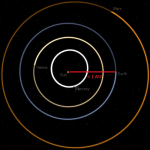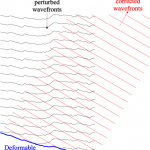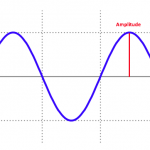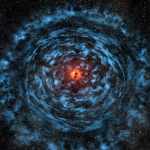Glossary of Radio Astronomy Terms
au:
Astronomical unit (au): A unit of distance equal to the average distance between the Earth and the Sun, or 149.6 million kilometers (93 million miles).

Absolute magnitude:
The apparent magnitude that a star would possess it if were placed at a distance of 10 parsecs from Earth. In this way, absolute magnitude provides a direct comparison of the brightness of stars.
Absolute zero:
The lowest possible temperature, from a thermodynamic, or heat/motion, perspective. A particle at absolute zero would experience almost no motion whatsoever, even subatomic motion, though some motion due to quantum effects is still possible. It is defined as 0 on the Kelvin scale (-273.15 degrees Celsius)
Absorption line:
A dark line or band at a particular wavelength on a spectrum, formed when a substance between a radiating source and an observer absorbs electromagnetic radiation of that wavelength.

Accretion:
The gathering of small particles as a result of collisions, which will eventually form celestial objects as they grow. This process is important in the evolution of stars, planets, and comets.
Accretion disk:
A disk of gas that accumulates around a center of gravitational attraction, such as a white dwarf, a neutron star, or a black hole. As the gas spirals in, it becomes hot and emits energy at a variety of wavelengths, including X-ray and radio waves.

Achromatic lens (achromat):
Two different-types of glass lens designed to reduce chromatic aberration by cutting down on the amount of false color in an image.
Active Galactic Nuclei (AGN):
A galaxy with an unusually bright central region thought to contain a supermassive black hole actively pulling in tremendous amounts of matter from a swirling disk of gas, stars, and dust.
See Supermassive black hole for more;Adaptive optics:
A technique used in astronomy to counteract the blurring effect of Earth’s atmosphere when viewing astronomical objects. Advanced ground-based optical/infrared telescopes use adaptive optics to match the performance of telescopes in space.

Alidade:
A device equipped with simple or telescopic sites used for determining a direction. This device works together with an astrolabe.

Altitude:
The angular distance of an object above the horizon.
Amplitude:
The size or strength of an electromagnetic wave that is measured in just one wavelength.

Amplitude Modulation:
Amplitude Modulation (AM): Changing the size or strength (amplitude) of a radio wave – or any carrier wave – to transmit information.
Angstrom:
A unit of length used to measure the wavelength of light. One angstrom is equal to one ten-billionth of a meter (about four-billionth of an inch). Visible light ranges from about 7,700 (red) to 3,900 (violet) angstroms.
Angular momentum:
The rotary inertia, or resistance of a change in speed or direction, of an object or systems of objects in motion on an axis. For example, the Earth’s angular momentum operates on an annual rotation around the sun.
Antimatter:
Matter consisting of particles with charges opposite that of ordinary matter. In antimatter, protons have a negative charge while electrons have a positive charge.
Aperture:
The size of the opening through which light passes in a telescope or the size of a dish in a radio telescope.
Aphelion:
The farthest point in a planet’s (or other body in the solar system) orbit around the Sun.

Apogee:
The point in a body’s orbit (e.g. the moon’s) around Earth where the orbiting body is the farthest from the Earth.

Apparent magnitude:
The measurement of how bright a star is from Earth. A very distant, very bright star can have the same apparent magnitude as a nearby, dim star.
Arc minute:
A measurement that tells you how big something in space appears from Earth. One arc minute = one sixtieth of a degree. For example, if a circle around Earth were divided equally into 360 degrees, the full moon would be approximately 30 arc minutes across.
Arc second:
A measure of angular separation, One arc second = one sixtieth of an arc minute. (1/3600th of a degree.)
Array:
An arrangement of two or more radio antennas working together by combining the data they each collect.
See ALMA, VLA, or VBLA for more;
Astrolabe:
An ancient device that was used to determine the location of stars and planets as well as the time of day, based on the sun’s position. It was developed in classical Greece before it was perfected by Islamic astronomers in the 12th century

Astrochemistry:
the branch of science that explores the chemical interactions between dust and gas interspersed between stars.

Astronomical unit:
Astronomical unit (AU): A unit of distance equal to the average distance between the Earth and the Sun, or 149.6 million kilometers (93 million miles).

Atacama Large Millimeter/submillimeter Array (ALMA):
Funded by the U.S. National Science Foundation and its international partners (NRAO/ESO/NAOJ), ALMA is among the most complex and powerful astronomical observatories on Earth or in space. The telescope is an array of 66 high-precision dish antennas in northern Chile.
See more here;
Axion:
Theorized low-mass particle of dark matter that may be responsible for holding galaxies together.

Azimuth:
The angular location of a celestial objects from the observer’s perspective. The azimuth is also a specific part on a radio telescope that allows it to rotate and follow a celestial object across the sky.







